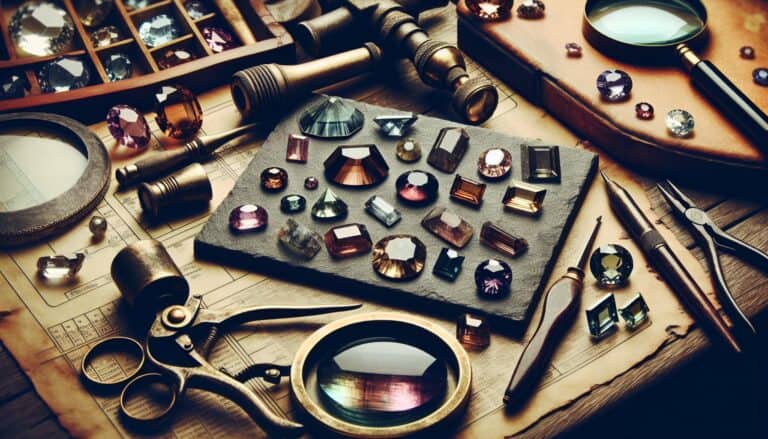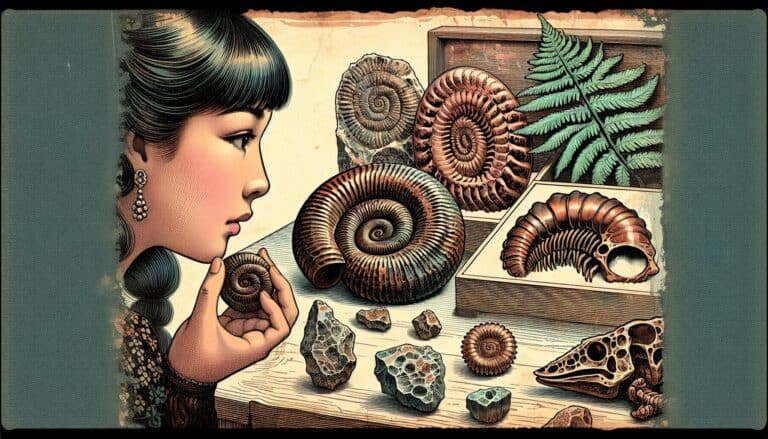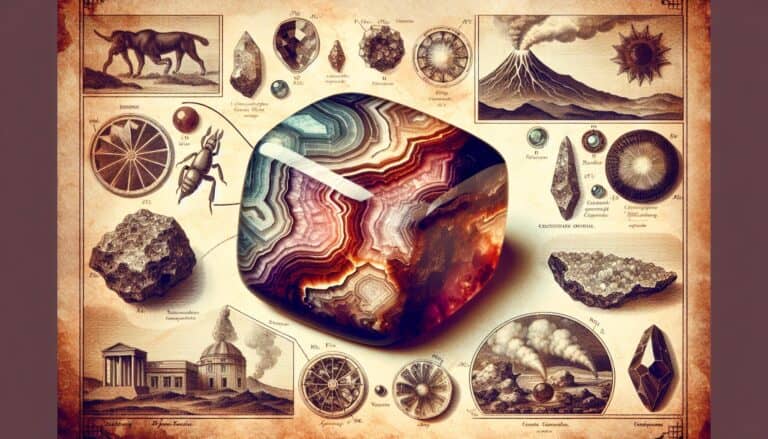Spotting wulfenite in the wild is like discovering a hidden gem—quite literally.
This mineral, known for its vibrant colors and unique crystal forms, is a collector’s dream. But how do you know if you’ve found wulfenite?
You’re in for a treat if you’re curious about identifying this striking mineral. With its distinctive characteristics, wulfenite stands out among the myriad of minerals.
Let’s delve into the key features that make wulfenite a standout find.
Orange blaze, thin and square, that’s wulfenite’s rare affair. White streak it leaves behind, resists magnet’s pull, not kind. Soft as chalk, bends light in two, near lead it waits for you.
How to Identify wulfenite Through Testing
Visual Inspection
When trying to identify wulfenite, start with a Visual Inspection. Observe the color, which typically ranges from orange to red. Wulfenite’s crystal habit should also guide you – it’s often found in thin tabular forms. Transparent to translucent crystal clarity is another hallmark.
The Streak Test
To perform the streak test, drag your wulfenite sample across an unglazed porcelain plate. Wulfenite will leave a streak that matches the color of the powder rather than the color of the crystal, often yellowish or white.
Magnet Test
Wulfenite is non-magnetic, so if your sample is attracted to a magnet, it’s likely not wulfenite. Always use a strong magnet to rule out any weak magnetic properties.
Hardness Test
Conduct the hardness test by attempting to scratch your sample with a tool of known hardness. Wulfenite falls between 2.75 and 3 on the Mohs hardness scale.
Birefringence Test
Under a polarizing microscope, wulfenite shows birefringence. When rotated on a stage, different colors will be visible due to birefringence, which isn’t present in isotropic minerals.
Checking the Diaphaneity
Diaphaneity refers to the transparency of the mineral. Wulfenite can be transparent to translucent, which means some light will pass through the material, making this a valuable visual assessment tool.
Single or Double Refraction
Wulfenite produces double refraction. Upon looking through a clear piece of the mineral at a single line or point, the image will double.
Refractive Index Test
Using a refractometer, the refractive index of wulfenite can be measured. The typical refractive index range for wulfenite is between 2.28 and 2.40.
Finding The Specific Gravity
The specific gravity of a mineral is the ratio of its density to that of water. For wulfenite, it’s approximately 6.5 to 7.0, which is high for a non-metallic mineral. You’ll need a balance scale for this test.
Identifying Wulfenites in the Field
In the field, look for wulfenite near lead deposits. Its bright colors and shared locality with galena are helpful indicators.
Recognizing Potential Wulfenite Rocks
Potential wulfenite-bearing rocks are often oxidized, meaning they’ll show signs of weathering with a rusted appearance. These rocks may also be found in the upper parts of lead ore deposits.
Physical Characteristics of wulfenites

Wulfenite’s distinct physical traits are key in its identification. Primarily, color ranges from bright orange-red to yellow, with less common greens and greys. You should look for its signature tetragonal crystals, often thin and tabular.
The crystal is known for its high luster, appearing adamantine to resinous. Pay attention to the way light reflects off the surface, as this can give you valuable clues about the mineral’s identity. Transparency varies from transparent to translucent, adding to the allure of wulfenite as a collector’s gem.
In terms of cleavage, wulfenite exhibits one distinct direction, which should be noticeable upon inspection. This single cleavage plane can result in breakage along perfect, flat surfaces. Take note of this when handling potential samples to avoid damage.
The mineral’s Mohs hardness typically falls between 2.5 and 3, which helps in distinguishing it from similar minerals. Here are some quick stats:
| Property | Description |
|---|---|
| Color | Orange-red, yellow, green, grey |
| Crystal Shape | Tetragonal, thin and tabular |
| Luster | Adamantine to resinous |
| Transparency | Transparent to translucent |
| Cleavage | One distinct direction |
| Hardness | 2.5 to 3 on Mohs scale |
Remember, handling wulfenite with care is crucial as its softness makes it vulnerable to scratches and chipping. Always carry a field kit for on-site testing to confirm your findings swiftly. Keep your eyes peeled for these characteristics next time you’re in the field, and you may just spot a sample of this striking mineral.
How Are wulfenite Formed?
Understanding the formation of wulfenite can help you identify it more accurately. Wulfenite originates in the oxidation zones of lead deposits where lead minerals react with oxygen and other elements. Here are the key processes involved:
Geological Conditions
Wulfenite formation requires specific conditions:
- There must be lead ore deposits.
- Oxygen must be present to create an oxidation zone.
- Molybdenum—the element crucial for wulfenite—must be available in the surrounding rock.
Formation Process
- When lead minerals like galena are exposed to oxygen, they start to oxidize.
- Molybdenum within the rock reacts with the oxygen and the lead minerals.
- This chemical reaction produces the distinctive tetragonal crystals of wulfenite.
Other Contributing Elements
Trace amounts of other elements often give wulfenite its varied color range:
- Chromium may result in deep red hues.
- Vanadium can produce bright orange colors.
Bear in mind the environment must remain relatively dry; excessive moisture can impede wulfenite crystal growth. So if you’re looking for potential wulfenite specimens, consider these conditions when scouting for locations. With your field kit at the ready, you’re well-equipped to test any potential finds following these formation guidelines.
Preparation for wulfenite Hunting
Gathering the Right Tools
Before heading out on your wulfenite hunting adventure, it’s essential to have the right tools at your disposal. Proper equipment not only makes the process more efficient but also ensures you don’t damage the delicate crystals you’re after.
- Geologist’s hammer: Ideal for carefully extracting specimens.
- Chisels: Useful for prying apart rocks without harming the wulfenite.
- Safety goggles: Protect your eyes from flying debris.
- Field guide or mineral identification app: Helps confirm the identity of wulfenite in the field.
Remember that wulfenite’s Mohs hardness is relatively low, so a light touch and precision tools are key. Pack a sturdy backpack to transport your finds safely, and add a few resealable bags to separate different specimens.
Safety Considerations
Your safety should always be your top priority. Mining areas and natural deposits can be treacherous, so it’s important to prepare accordingly.
- Wear protective clothing: Long sleeves and pants can minimize skin exposure to sharp rocks and potentially harmful minerals.
- Bring a first-aid kit: Always have basic supplies on hand for minor injuries.
- Stay hydrated: Keep plenty of water with you, especially if hunting in arid regions where wulfenite is common.
- Inform someone of your plans: Make sure someone knows where you’re going and when you expect to return.
You’ll also want to respect local regulations and obtain any necessary permissions before wulfenite hunting. Some areas may be protected, and collecting without authorization can result in heavy fines. Equip yourself with sufficient knowledge about the terrain, potential hazards like wildlife or unstable ground, and prepare to navigate them safely.
Handling and Care of Found wulfenites

Cleaning and Storing Wulfenites
When you’ve successfully located and collected wulfenite samples, it’s crucial to clean and store them properly to maintain their integrity. Start with a soft brush to gently remove any loose dirt without scratching the mineral. Wulfenite’s Mohs hardness of about 3 means it scratches easily, so avoid hard bristles or aggressive cleaning methods.
For dirt that’s not brush-offable, opt for room-temperature water. The use of chemicals or hot water could potentially damage the delicate structures. After a rinse, pat the crystals dry with a soft cloth—rubbing can lead to scratches.
Your storage method matters as well. Each wulfenite sample should have its own space, preferably wrapped in tissue paper or placed in a padded container. Contact with harder minerals or even other wulfenite pieces could cause abrasions. Climate control is another factor; you’ll want to store your specimens in a relatively stable, humidity-controlled environment to prevent any alterations due to moisture or temperature changes.
In terms of display, consider small display cases or stands that minimize handling. Remember, limiting physical contact not only preserves the crystal’s structure but also its brilliant luster. Keeping your finds in top condition allows you to showcase the radiant colors and unique tetragonal structure that make wulfenite a collector’s delight.
Conclusion: Confirming Wulfenite is Real
With the right approach, you’ll find that identifying wulfenite can be a rewarding experience.
Remember to rely on the distinct physical properties of wulfenite—its unique crystal structure, luster, and color spectrum—to guide you. Your field kit, coupled with a cautious touch, will help you test and confirm your finds without causing damage. Always stay informed about the geological backdrop that fosters wulfenite formation and be prepared with the necessary tools and safety measures. Once you’ve successfully located and collected your specimens, taking care of them is paramount. Clean gently, store carefully, and display proudly, ensuring your wulfenite samples remain as brilliant as the day you found them.
Happy hunting!







